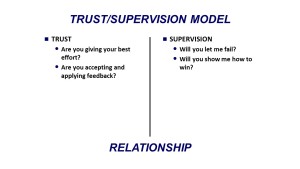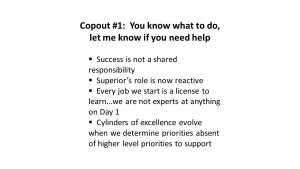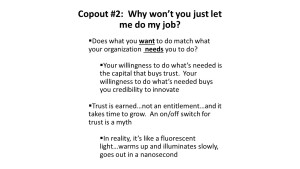Relationships can affect capacity for doing as much as processes. One of the most critical relationships in a working environment, personally and professionally, revolves around handling the line between trust and supervision.
The premise of this discussion is the idea that the line between trust and supervision is not a barrier. In reality, it’s a thin line that bosses and workers (even peers) cross over on a near daily basis. Over time, the product of the interaction that comes from crossing the line grows into a powerful relationship that increases capacity for significant action.
Let’s begin with some definitions to frame the discussion. Here is what the dictionary says about trust:
trust (trŭst) n.
- Firm belief in the integrity, ability, or character of a person or thing; confidence or reliance: trying to gain our clients’ trust; taking it on trust that our friend is telling thetruth.
- The condition and resulting obligation of having confidence placed in one: violated a public trust.
- One in which confidence is placed.
As you can tell, the definition of trust centers on the concept of confidence…assured dependability comes to mind when describing confidence in a person, organization, process, or idea. Assured dependability does not come easy, and we consistently underestimate the time and commitment it takes to achieve trust at that level. Take a look at the following video I found on YouTube and you’ll see what I mean:
Supervision on the other hand describes something different…let’s consult the dictionary again:
su·per·vise
(so͞o′pər-vīz′)
tr.v. su·per·vised, su·per·vis·ing, su·per·vis·es
To manage and direct; be in charge of: supervises twenty employees; supervised the construction of the new kitchen.
As you can tell by the definition, we’re talking about effectiveness in accomplishing tasks. But the definition glosses over something that’s very important…tasks are accomplished by people who in general want to do well and be effective. Through the process of supervision, we build the assurance that generates a relationship of trust and enables an even higher level of achievement. Take a look at this YouTube video and you’ll see what I mean through a couple of humorous examples of effective…and highly ineffective…supervision.
In establishing the line between trust and supervision, there are two questions specific to each that ultimately determines where the line falls. Look at the following storyboard on the trust/supervision model:
If you are being supervised, there are essentially two questions you want answered in order for a relationship to evolve with the supervisor. The first, is will you let me fail. I could write another deep dive on the difference between mistakes and failure; in this case, we’re not talking about mistakes that are a natural byproduct of the learning process and a person is genuinely giving their best effort.
When I talk about failing in this sense, I’m talking about a situation from which there is no recovery. The impact could be loss of life, destruction of property, or termination of employment. No matter what a worker is saying about independence and having space to work, there is always an unspoken desire to know there is a safety net around them; in other words, they not on an island alone.
The other question, will you teach me to win, speaks directly to every human’s desire for fulfillment. There would be no such thing as heroes and Rocky wouldn’t have won our hearts if people didn’t come alive at the thought of winning. In general we look for ways to do more, progress, surpass previous levels, or improve a product or process. Supervisors that do the hard work to make people better rather than safeguard the status quo make the workplace fulfilling and meaningful as they build trust.
Thus far we’ve talked about supervision and the obligation to set safe boundaries and foster fulfillment. It’s a complete myth to believe that all accountability rests with supervision for building trust. If you are a supervisor, there are two questions you want answered in order for your relationship to turn into trust.
The first is settling the issue of whether or not you are giving your best effort. Reflecting upon the definition of trust…confidence or assured dependability…it’s easy to see how trust cannot grow in a garden of mediocrity.
If you want to be trusted, be trustworthy. The key elements of being trustworthy can be remembered through and acronym…ICE…integrity, competence, effort. If you consistently show up with a bucket of ICE, you will gain the trust of your boss and gain greater freedom for significant achievement.
The other question that determines whether you gain trust is whether you’re willing to accept and apply feedback. If you are not doing a task correctly or spending your effort on established priorities…and you’re unwilling to act upon feedback to change…can you honestly be surprised that you’re not trusted?
Willingness to apply feedback and correct behavior or processes demonstrates something very important…commitment to the team. When you place your way of doing things over the best interest of your organization, it affects far more than you, and in turn your ability to contribute is marginalized because you are not trusted. Isn’t it ironic…the more you’re willing to do what is needed, the more freedom you gain to do what you want!
This all seems so obvious that you may wonder why we’re doing a deep dive on the subject. World class supervision that builds trust is a tough process that takes time and patience. Not all want to invest the effort it takes to get there and they have cultivated some powerful myths and copouts that you may give credibility. The following storyboards highlight a couple:
I’m sure you’ve heard this copout and it sounds like you may have a lot of freedom. What’s insidious is that statement signals a blatant unwillingness to share in your success…or failure. If we always knew what to do, why to do it, when to do it, and when we’re getting in over our heads, we wouldn’t need supervisors.
This statement also signals a reactive rather than proactive role in shaping the work environment and your pathway to advancement (you’ll remember Critical Doer philosophy states the only future we have is the one we’re willing to make for ourselves). This statement will also turn a team into a confederation…an association that has common interests but not commitment to each other. Absent proactive guidance, we establish our own priorities that while well-meaning actually conflict with others and reduce an organization’s capacity to achieve.
Many people never learn that you were hired to do what your organization needs you to do…which may not be exactly what you want to do. Many times when we use this copout, the underlying cause is conflict between organizational need and personal preference during periods of change. Remember, if you’re not giving proper consideration to the success of your organization, it’s difficult to achieve trust. Trust is not an entitlement…it must be earned and the accountability is on you to be trustworthy enough to get it.
Micromanagement is a topic that should be addressed with this copout. Here’s a bitter pill of truth…the accountability for micromanagement does not rest entirely on the boss. I’ve been micromanaged twice in my career…looking back, I have to admit it was largely my fault. In the storyboard showing the line between trust and supervision, can you guess what the line actually represents? It’s communication.
In both cases where I was micromanaged, I failed to recognize my boss needed me to communicate differently than my previous boss or how I thought I should communicate. If you picked up on how many times I used “I” in that vignette, you’re picking up on the problem. Because I didn’t communicate the way the boss needed, it drew a closer level of supervision and loss of freedom. Had I adapted to the needs of the boss for communication, perhaps it would have turned out differently.
Here’s one last storyboard to summarize our discussion today:
Supervision is owed, trust is earned. When trust occurs, it is a force multiplier that unleashes ideas and effort that maximizes an organization’s full potential for achievement. It does the same for individuals who want their legacy to be one of high achievement.
Take a fresh look at your current situation see if there are ways you can better answer the two questions we have of our supervisors. Take a look at yourself and see if there are ways you can better answer the mail on earning trust. Beware of the copouts and ensure you communicate effectively, up and down the chain, in order to build trust that provides freedom for achievement and fulfillment. It’s what a Critical Doer would…do!
Reminder: you can get automatic updates from The Critical Doer by using the subscription widget at the bottom of this post. You can also follow on Facebook, Twitter, and Google+. I also encourage you to let me know what you think of the posts or share a story of your own using the comments section or email me directly at [email protected].



